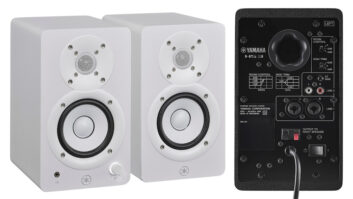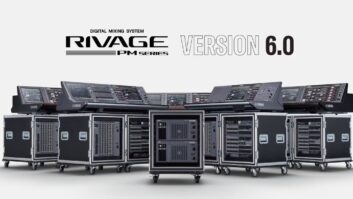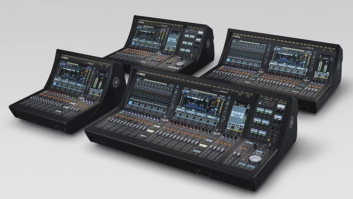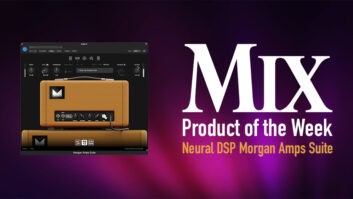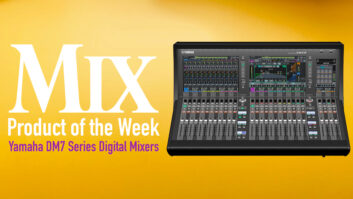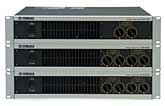
Yamaha’s XM Series amps
At this week’s NSCA Convention, Yamaha unveiled their new XM Series multi-channel power amplifiers, available in three models—the XM4080, XM4180 and the high impedance XH200—as well as upgrades to its DME24N and DME64N programmable DSP processors with Versions 1.1.
Delivering in the third quarter of 2005, the new XM Series amplifiers replace current models XM4220, XM6150 and XH150 and have been redesigned from 3RU to 2RU, 22-pound packages. Each channel can drive similar or different speaker types—such as multiple stage monitors and/or a multi-zone system—from the same amplifier, while retaining a > 60dB signal separation between channels.
The XM4080 delivers four channels of 80-watt power into 8 ohms; four channels at 115 watts into 4 ohms; or two bridged mono channels of 230 watts. The XM4180 offers four channels of 180-watt power into 8 ohms; four channels at 250 watts into 4 ohms; two channels of 500 watts, 8 ohm bridged mono; or two channels of 300-watts (70v @ 16 ohms), bridged. The high impedance XH200 delivers two channels at 200 watts, and is capable of driving standard, 70-volt and 100-volt distributed speaker systems.
The XM4080, XM4180 and XH200 are UL-rated, and maintain efficiency, low current draw and reduced heat by utilizing Yamaha’s proprietary EEEngine Technology. The new series has been designed with three input modes: normal Stereo Mode routes separate input signals to independent channels with L/R signal control; Parallel Mode routes a single input to two independent channels with L/R signal control; and Bridged Mono Mode, which provides the highest power output.
All channels contain a 31-position input attenuator, signal indicators and high-pass filters for increased signal quality and accurate system level matching. Each channel contains both professional balanced XLR and Euro-block input connectors, plus 5-pole binding-post outputs connections. A D-Sub data port connection allows external monitoring of all amplifier functions from a PC.
Versions 1.1. Free downloads of the Version 1.1 upgrade to the DME24N and DME64N programmable DSP processors, which provide nearly 30 new features, are currently available at www.yamahaproaudio.com and notated as DME24N V1.1 and DME64N V1.1.
In addition to an ability to control the system from Ethernet, USB, RS232/422 or MIDI, Yamaha engineers have added several new components, including an SPX-type processor with up to 43 4-stereo/SPX-type effects similar to those found on the DM2000 digital mixing console. A “Freeze” effect feature has been added as a .WAV file player, providing up to one minute of 16-bit Stereo WAV file playback
The new “Crossover Processor II” provides improvements in crossover processing with 6-band parametric EQs, a MUTE button on the input section, and polarity switches on all channels, an ideal feature for line array systems. (Crossover Processor II remains compatible with DME systems using Crossover Processor I).
Version 1.1 also includes “Event Logger,” which stores error or warning messages in the DME24 or DME64N hardware and downloads to a PC. The “Event Scheduler” automatically enables scene recall or parameter change execution from the event scheduling list. “Component Lock” will lock any or all system components so the systems cannot be controlled externally. The “Thru” function on the Utility menu ensures that all audio passes through to all outputs on MY Series card slots—useful for complete system checks. A new “System Backup” feature allows all user data input to download to the DME Designer. Other additions include “Print Component” for printing parameters, “Export Component” for CSV file format export, and “Auto Delay Compensation” for automatic component adjustments.
Users can expand their systems by using the DME64N or DME24N and the new 8-channel Yamaha MY8-ADDA96—an eight input/output analog card equipped with mini Euroblock connections and capable of handling 24-bit/96kHz audio. The MY8-ADDA96 consumes low power, allowing multiple cards to be used in a single unit. The MY8-ADDA96 may be used with any Yamaha product that will accept MY Series mini-YGDAI expansion cards, and does not require firmware upgrades.
For more information, visit Yamaha at NSCA 2005, Orange County Convention Center, Demo Room N220G or Booth 0709; or log on to www.yamaha.com/proaudio.
